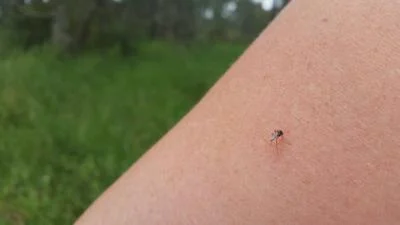Tick Bites- Causes, Symptoms, Treatment & Prevention

A tick bite is a bite from a tick, which is a small, spider-like arthropod that feeds on the blood of mammals, birds, and sometimes reptiles and amphibians. Ticks are commonly found in wooded and grassy areas, and can attach themselves to a person or animal that brushes past them. Ticks have a small, hard body with eight legs and a head with a pair of sharp jaws. They use these jaws to attach themselves to the skin of a host and feed on the host’s blood.
Also Read:- Sun Poisoning: Symptoms and Treatment
Most tick bites do not cause any symptoms, but a small percentage of tick bites may result in infection with Lyme disease, other types of tick-borne diseases, or in some cases, cause an allergic reaction. Symptoms of tick-borne diseases can include fever, headache, fatigue, muscle or joint pain, or a rash. In most of the cases, the tick has to be attached for at least 24-48 hours for the disease to be transmitted.
Tick bites should be watched carefully for signs of infection or allergic reaction,and if any symptoms occur or a tick is found burrowed into the skin, it’s important to speak with a doctor. They can check the tick, remove it and if necessary, provide an appropriate treatment.
The majority of the time, tick bites are painless and unsymptomatic. However, some tick species can transmit diseases to people and pets when they bite, and others can trigger allergic reactions. If these illnesses are not treated right away, they can be serious or even fatal.
In the US, ticks are quite prevalent. They reside outside in:
- grass
- trees
- shrubs
- leaf piles
They may easily transition between people and their four-legged companions since they are drawn to both. You’ve probably come across ticks at some point if you’ve spent any time outside.
In this post, we’ll explain how to recognise ticks and tick bites, as well as the signs of illnesses spread by ticks and what to do if you get bitten by a tick.
What do ticks look like?
Ticks are small, spider-like arthropods that vary in size depending on the species and their stage of development. Adult ticks are generally about the size of a sesame seed, and can be reddish-brown, dark brown, gray, or black in color. They have a small, hard body with eight legs and a head with a pair of sharp jaws. Some ticks can be as small as a pinhead and may be difficult to see.
When a tick is engorged, or full of blood, it will appear larger and more elongated. They can also change color after feeding.
It’s important to know that not all ticks carry disease, and not all tick bites will transmit illness. But prompt removal of a tick may reduce the risk of infection, so it’s always a good idea to inspect your skin if you have been in tick-prone areas, and remove any tick that you find attached to your skin as soon as possible.
Where do ticks bite people?
Ticks can bite people anywhere on the body, but they are most likely to attach to areas of the skin that are thin and moist, such as the scalp, armpits, groin, and behind the knees. They also tend to attach to areas that are warm and have a high concentration of blood vessels close to the surface of the skin, such as the back of the neck, upper chest, and the upper legs.
When a tick attaches to the skin, it inserts its feeding tube into the skin and begins to feed on the host’s blood. The tick’s body will swell as it becomes engorged with blood. Ticks typically remain attached to the skin for several days while they feed.
It’s important to check your skin, especially if you have been in wooded or grassy areas, since the tick’s bites are usually painless, so the person may not know that they have been bitten. Also, it’s good to know that not all ticks carry disease, and not all tick bites will transmit illness, but prompt removal of a tick may reduce the risk of infection.
Warm, wet parts of the body are preferred by ticks. The Centers for Disease Control and Prevention (CDC)Trusted Source claims that once a tick has attached itself to your body, it will probably move to the following locations:
- armpits
- groin
- hair
- back of your knees
- inside your belly button
- around your waist
- inside and around your ears
Ticks don’t always migrate, though. Check your entire body if you’ve recently been in a situation where a tick bite might have occurred.
The tick bites into your skin and starts drawing blood when it finds a prime location. Ticks often remain attached to your body when they bite you, unlike the majority of other biting insects.
You’ll most likely discover a tick on your skin, which will let you know if a tick has bitten you. Most likely, you won’t feel the tick bite you as it happens.
An engorged tick will separate from your body and fall off after up to 10 days of sucking blood from you.
How can you tell if you’ve been bitten by a tick?
In most cases, tick bites are painless, so people may not know that they have been bitten. However, there are some signs and symptoms that can indicate a tick bite.
Here are some common signs of a tick bite:
- A small, red bump or a red ring around the bite. This is the body’s normal response to a foreign substance, such as the tick’s saliva, entering the skin.
- Swelling or redness around the bite site.
- Itching or a burning sensation around the bite site.
- A small black or dark brown spot on the skin, which is the tick.
- Flu-like symptoms such as fever, fatigue, headaches, and muscle aches which may develop within a week of being bitten.
However, It’s important to note that not all tick bites will cause these symptoms and sometimes the tick might not even be found on the skin. If you suspect that you have been bitten by a tick and are experiencing any symptoms, it’s important to seek medical attention. It’s also important to keep a close watch for any signs of infection or tick-borne illness and report it to a doctor.
Symptoms of tick-borne diseases
Symptoms of tick-borne diseases can vary depending on the type of disease and the person’s individual immune response. Some common symptoms that may develop several days or weeks after a tick bite include:
- Fever
- Headache
- Fatigue
- Muscle or joint pain
- A bull’s-eye shaped rash around the bite site, which is a classic symptom of Lyme disease, but not all infected people develop this rash.
- Nausea or vomiting
- Loss of appetite
- Chills or sweating
Some tick-borne diseases may cause more severe symptoms, such as:
- Neurological symptoms such as confusion, numbness or weakness in the limbs, and difficulty speaking or walking
- Cardiac symptoms such as chest pain or an irregular heartbeat
- Blood disorders
- Allergic reactions to tick saliva such as hives, itching, and difficulty breathing
Symptoms of tick-borne diseases can also vary depending on the stage of infection. In some cases, early symptoms may resolve on their own, only to be followed by more serious symptoms that occur weeks, months, or even years later.
It’s important to know that not all tick bites will transmit illness, and that not all tick-borne diseases have the same symptoms. If you suspect you have been bitten by a tick and have symptoms of an infection, you should seek medical attention right away.
How are tick bites treated?
Tick bites can be treated by cleaning the bite area with soap and water and then applying an antiseptic. You can also apply a cold pack to the area to reduce pain and swelling. Over-the-counter pain relievers such as ibuprofen or acetaminophen can also be used to relieve pain and inflammation. In some cases, a tick-borne illness may occur, in that case antibiotics may be needed to treat the infection. If you develop a rash or fever within several weeks of a tick bite, see a doctor.
The removal of the tick is the most crucial action to do when you detect one. This could aid in preventing a disease spread by ticks. If you are experiencing an allergic response, don’t remove it because doing so could release additional allergen and exacerbate your symptoms.
After the tick has been removed, make sure to thoroughly clean the area with an antibacterial cleanser or cream. Your doctor might decide to send the tick to a lab for identification and to see if it’s carrying any infections.
Bring the tick with you to your doctor’s appointment in a container with a lid or a sealed ziplock bag.
Whether you have a tick-borne disease or an allergic reaction to the insect bite will determine your course of treatment.
How can you prevent infections from tick bites?
To prevent tick bites and tick-borne infections, you can take the following steps:
- Wear long sleeves and pants: Ticks are more likely to bite exposed skin, so wearing long sleeves and pants can help protect you.
- Use insect repellent: When spending time outdoors in areas where ticks are prevalent, use an insect repellent containing DEET or permethrin.
- Stay on well-traveled paths: Ticks are often found in tall grass, so staying on well-traveled paths can help you avoid them.
- Check for ticks: After spending time outdoors, thoroughly check your body for ticks, paying close attention to areas like your scalp, armpits, and groin.
- Shower soon after being outdoors: Taking a shower within two hours of coming indoors can help wash off any ticks that haven’t yet attached to your skin.
- Keep ticks out of your yard: Remove tall grass, leaf litter, and brush from around your house and keep your lawn mowed short.
It’s also important to know that If a tick is attached to your skin for more than 24 hours, the risk of infection increases. Always use tweezers to remove tick and do it carefully, avoid squeezing the tick. If you find a tick attached to your skin, it’s important to remove it as soon as possible.
Frequently asked questions about tick bites
There are several common questions people have about tick bites:
1. What are the symptoms of a tick bite?
Symptoms of a tick bite can include redness, itching, and pain at the site of the bite. A bull’s-eye shaped rash, fever, and flu-like symptoms can also occur in some cases, especially if the tick was carrying a disease-causing organism.
2. How do I remove a tick?
Use fine-tipped tweezers to grasp the tick as close to the skin’s surface as possible. Pull upward with steady, even pressure. Clean the bite area and your hands with rubbing alcohol or soap and water.
3. How long after a tick bite will symptoms appear?
Symptoms of tick-borne illnesses may appear anywhere from 3 to 30 days after a tick bite.
4. Can a tick bite be prevented?
Preventing tick bites is key to prevent tick-borne illnesses. Wearing long sleeves, using repellents, staying on trails and checking for ticks after being in tick-endemic area are some measures to take in order to avoid tick bites.
5. Can you get a tick-borne disease even if the tick doesn’t attach?
The risk of infection from a tick increases the longer the tick is attached, so it’s less likely that you’ll get a tick-borne disease if the tick is removed quickly. However, not all tick-borne illnesses can be transmitted by tick immediately, some needs tick to be attached for certain period of time.










